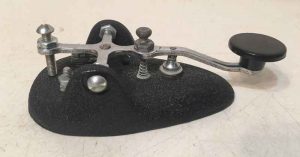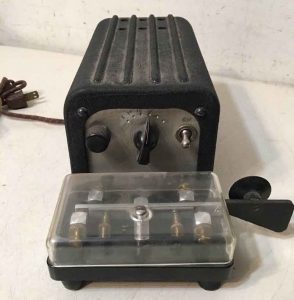
Friday, Nov. 17, 2017 — I’ve spent the past two weeks plus enjoying my new-to-me rig for Studio B — a Yaesu FTDX-3000, and I thought it time to share my observations about the rig.
Initially, I wasn’t considering the FTDX-3000. The two rigs I was considering were both Yaesus — the FT-991 and the FT-1200. I really didn’t need a mobile-sized rig, though the FT-991 looks like a very feature-rich rig with a really nice display (nicer than most other Yaesu HF mobile rigs).
While I was evaluating those rigs, I ran across some really nice deals on some gently used FTDX-3000 rigs on that dang auction website, so I included a third rig in my research — and it quickly became the rig I decided to purchase.
 Two other rigs I looked at but didn’t opt for were both Icoms — the IC-7300 and the IC-7600. This was due simply to the fact I didn’t have enough cash on hand to go high enough to buy an IC-7300, much less the IC-7600. The IC-7600 is ideally the rig I would like to end up with sometime, it is the descendant of the IC-756xx series, and given how much I like that series, it makes sense to update with the purchase of the latest version. Well, it made “sense” but I didn’t have enough “cents,” to be honest.
Two other rigs I looked at but didn’t opt for were both Icoms — the IC-7300 and the IC-7600. This was due simply to the fact I didn’t have enough cash on hand to go high enough to buy an IC-7300, much less the IC-7600. The IC-7600 is ideally the rig I would like to end up with sometime, it is the descendant of the IC-756xx series, and given how much I like that series, it makes sense to update with the purchase of the latest version. Well, it made “sense” but I didn’t have enough “cents,” to be honest.
One ham blogger began his review of the FTDX-3000 as it was “unlike any Yaesu I’ve every listened to.” I whole-heartedly agree.
First, let’s look at the price. I picked up mine in great shape for $1,200 on the used market. Its not the latest and greatest rig, but still at least a generation newer than my other HF rigs. For $1,200, it offered a tremendous bang-for-the-buck.
Now I’m not a lab rat when it comes to reviewing a rig. I don’t know the specs of the rigs I use, but I know when I like what I’m hearing, and the FTDX-3000 really is the best sounding rig I’ve ever owned.
There are fewer knobs and buttons than my FT-2000, but that’s to be expected given the smaller size. The built in scope isn’t as useful as those in the 756 series, mostly because its shorter than the 756 scopes. It’s still useful, but the compressed vertical size makes it harder to see smaller peaks.
The menu for the FTDX-3000 is very similar to that found on the FT-2000; it wasn’t difficult to find what I needed to find (other than the button to turn on the CW keyer — see below).
The received audio is nothing short of spectacular — and that’s without any particularly filtering engaged. Despite 30 years as a ham, I’m not sure I can quantify exactly what it is about the audio quality that sounds so nice; just that I love how it sounds to my ears. Maybe its just the effect of my hearing loss because of too much rock ‘n’ roll, I’m not sure.
Admittedly, I have only operated the rig on CW to date. Its a really nice CW rig, and I find the controls for the DSP are easier to manage that my FT-2000. I liked the fact the 3000 has the same type of tuning offset indicator for use with CW as the FT-2000 does. If you haven’t used that feature, it is simply an indicator that allows you to tune a CW signal to the same pitch as your offset; its like zero beating without actually comparing the received signal with the sidetone. Not a feature that I would kill for, but I used it a lot with my FT-2000 and it was a welcome feature on the  FTDX-3000.
FTDX-3000.
Right now the mic I have here in Studio B is a Heil Classic. I put it in when I was running the IC-756PROII; of course, when I bought the Yaesu, I had to change microphone cables. The Heil Classic is the mic that Heil used to have that looks like the old RCA mic. They sold it with a mic flag that I never really liked that well; the mic I bought didn’t come with the flag, so I didn’t mind one bit. I have the Yaesu to 4-pin XLR cable right here, just haven’t changed it out yet. The mic is on a Heil boom and hanging upside down from how it is oriented on a desk stand.
HAVE YOU BOUGHT A TOM FRENCH KEY YET? Its been pretty fascinating to watch the key collection of noted key collector and author Tom French appear on eBay. I have missed some really great deals (still kicking myself), and picked up a couple of things. I’m pretty much out of space to add substantially to my collection, though my wife told me if I wanted to invest in some of Tom’s items to feel free to do so, but carefully.
To me, that’s a green light to spend … but was it? No, what she meant was if I saw some items that I believed would appreciate, I had her permission to invest … carefully.
The truth is that I get keys that a) I can afford, and b) keys I want — future value isn’t really a consideration. I collect keys because I enjoy them. If I can sell them later and make a buck or two, so be it. I haven’t purchased any of his keys as investments, despite my wife’s cautious approval.
I did pick up a few things … a very nice McElroy stream key straight key; a Bunnell Gold Bug (late version with the adjustable finger piece); a McElroy A-400 Mac Key (the first Mac Key that lacked the ends of the “T” bar) and a Mon-Key electronic key from Tom’s collection, both keys mentioned a few posts back. I have a little money in the ham radio fund, I’ve been selling some of my gear that did not sell at the hamfest in September so if something else comes up I may have enough cash to at least make one competitive bid, hi hi!
That’s it this time … 73 and CUL de KY4Z … SK … dit dit …

Your stock A-400 McElroy looks nice!
The A-400’s are some what more rare than the other late Mac’s